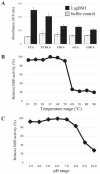Identification of Bile Salt Hydrolase and Bile Salt Resistance in a Probiotic Bacterium Lactobacillus gasseri JCM1131T
- PMID: 34066735
- PMCID: PMC8151060
- DOI: 10.3390/microorganisms9051011
Identification of Bile Salt Hydrolase and Bile Salt Resistance in a Probiotic Bacterium Lactobacillus gasseri JCM1131T
Abstract
Lactobacillus gasseri is one of the most likely probiotic candidates among many Lactobacillus species. Although bile salt resistance has been defined as an important criterion for selection of probiotic candidates since it allows probiotic bacteria to survive in the gut, both its capability and its related enzyme, bile salt hydrolase (BSH), in L. gasseri is still largely unknown. Here, we report that the well-known probiotic bacterium L. gasseri JCM1131T possesses BSH activity and bile salt resistance capability. Indeed, this strain apparently showed BSH activity on the plate assay and highly tolerated the primary bile salts and even taurine-conjugated secondary bile salt. We further isolated a putative BSH enzyme (LagBSH) from strain JCM1131T and characterized the enzymatic function. The purified LagBSH protein exhibited quite high deconjugation activity for taurocholic acid and taurochenodeoxycholic acid. The lagBSH gene was constitutively expressed in strain JCM1131T, suggesting that LagBSH likely contributes to bile salt resistance of the strain and may be associated with survival capability of strain JCM1131T within the human intestine by bile detoxification. Thus, this study first demonstrated the bile salt resistance and its responsible enzyme (BSH) activity in strain JCM1131T, which further supports the importance of the typical lactic acid bacterium as probiotics.
Keywords: Lactobacillus gasseri; Ntn-hydrolase family protein; bile salt hydrolase; probiotics.
Conflict of interest statement
The authors declare no conflict of interest.
Figures






Similar articles
-
Bile Salt Hydrolase Degrades β-Lactam Antibiotics and Confers Antibiotic Resistance on Lactobacillus paragasseri.Front Microbiol. 2022 Jun 6;13:858263. doi: 10.3389/fmicb.2022.858263. eCollection 2022. Front Microbiol. 2022. PMID: 35733973 Free PMC article.
-
Isolation of a Highly Thermostable Bile Salt Hydrolase With Broad Substrate Specificity From Lactobacillus paragasseri.Front Microbiol. 2022 Feb 17;13:810872. doi: 10.3389/fmicb.2022.810872. eCollection 2022. Front Microbiol. 2022. PMID: 35250928 Free PMC article.
-
Bile Salt Hydrolase (Bsh) Activity Screening of Lactobacilli: In Vitro Selection of Indigenous Lactobacillus Strains with Potential Bile Salt Hydrolysing and Cholesterol-Lowering Ability.Probiotics Antimicrob Proteins. 2012 Sep;4(3):162-72. doi: 10.1007/s12602-012-9101-3. Probiotics Antimicrob Proteins. 2012. PMID: 26782042
-
Probiotics and the BSH-related cholesterol lowering mechanism: a Jekyll and Hyde scenario.Crit Rev Biotechnol. 2015;35(3):392-401. doi: 10.3109/07388551.2014.889077. Crit Rev Biotechnol. 2015. PMID: 24575869 Review.
-
Review on the Function, Substrate Affinity, and Potential Application of Bile Salt Hydrolase Originated from Probiotic Strains of Lactobacillus, Bifidobacterium, and Enterococcus.Food Sci Anim Resour. 2025 Mar;45(2):353-374. doi: 10.5851/kosfa.2025.e1. Epub 2025 Mar 1. Food Sci Anim Resour. 2025. PMID: 40093624 Free PMC article. Review.
Cited by
-
Screening for potential novel probiotic Levilactobacillus brevis RAMULAB52 with antihyperglycemic property from fermented Carica papaya L.Front Microbiol. 2023 Jun 20;14:1168102. doi: 10.3389/fmicb.2023.1168102. eCollection 2023. Front Microbiol. 2023. PMID: 37408641 Free PMC article.
-
The Probiotic Potential and Metabolite Characterization of Bioprotective Bacillus and Streptomyces for Applications in Animal Production.Animals (Basel). 2024 Jan 25;14(3):388. doi: 10.3390/ani14030388. Animals (Basel). 2024. PMID: 38338031 Free PMC article.
-
New insights into microbial bile salt hydrolases: from physiological roles to potential applications.Front Microbiol. 2025 Feb 12;16:1513541. doi: 10.3389/fmicb.2025.1513541. eCollection 2025. Front Microbiol. 2025. PMID: 40012771 Free PMC article. Review.
-
Lactobacillus gasseri LA39 promotes hepatic primary bile acid biosynthesis and intestinal secondary bile acid biotransformation.J Zhejiang Univ Sci B. 2023 Aug 15;24(8):734-748. doi: 10.1631/jzus.B2200439. J Zhejiang Univ Sci B. 2023. PMID: 37551559 Free PMC article.
-
Functional efficacy of Enterococcus faecium HN4 and Lactobacillus delbrueckii HN5 strains isolated from human milk.Future Microbiol. 2025 Apr;20(6):479-488. doi: 10.1080/17460913.2025.2484924. Epub 2025 Mar 28. Future Microbiol. 2025. PMID: 40152419
References
Grants and funding
LinkOut - more resources
Full Text Sources
Molecular Biology Databases
Research Materials

